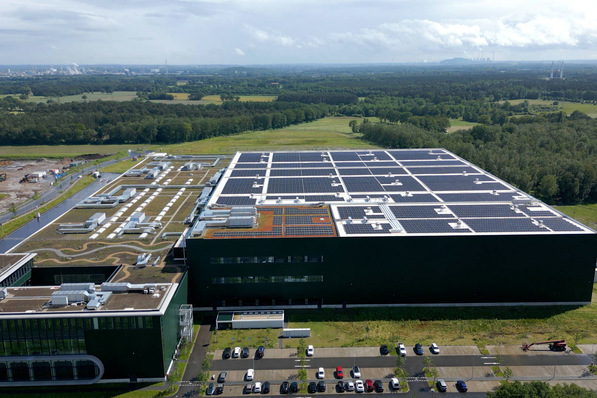EWS is focusing on Northern Europe. What does that mean and how does EWS see market development in the focus markets?
Jan Paul Dahm: Alongside Germany, we are focusing on the Netherlands and Scandinavia, but of course we also supply customers in Belgium, Austria, among others. Unfortunately, all Northern European countries are currently experiencing a decline in demand because PV components have been in short supply everywhere in the last two years and production capacities were massively expanded.
We believe that the main reasons for the current reluctance are high interest rates, lower electricity prices and, unfortunately, intransparent policies. The fact that politicians do not understand the uncertainty they are creating with their reluctance to take necessary decisions and measures seems to be a cross-border problem.
As a result, many warehouses in all parts of the retail chain are still well stocked and prices are continuing to spiral downwards, even for mainstream products from well-known manufacturers.
Can you see any light in the darkness?
Yes, prices for full black and glass/glass modules, for example, are rising again, and for all other product groups the downward trend is at least slowing down noticeably.
Another very positive "cross-border trend" is the self-consumption of the electricity produced to optimise the economic efficiency of the systems. This makes the industry less dependent on subsidies and political sentiment.
It also raises awareness of issues such as sector coupling, electricity storage or time-varying electricity tariffs. Although this means that systems require more explanation to the end customer, it has great potential in terms of both cost-effectiveness and CO2 savings.
What role do the neighbouring countries play for EWS as a German distributor?
A big one! Most of the "foreign markets" are much closer to our location on the Danish border than they are to Bavaria, which of course gives us logistical advantages. We have invested a lot, not only in native-speaking customer advisors and customer service, but also, for example, in five more language versions of our software solutions.
One exciting thing that all these PV markets have in common is that battery storage, at least in the residential sector, is just being discovered. In Germany, we are used to virtually every rooftop system being offered with a battery, and EWS alone has sold over 100,000 systems. We now want to share our experience with our trading partners in neighbouring countries.
So you think there is a lot of catching up to do in terms of home storage know-how? On the part of customers or installers?
Both, I would say. The need for education and training is very high at the moment in all our overseas markets.
It's not about how to mount or connect a battery storage system - that's relatively simple compared to the rest of the PV system. But there is still a lot of uncertainty when it comes to selling to end customers or designing a storage system. Rules of thumb are not enough to make a PV storage system cost effective and attractive to the end customer.
What help is there for installers when it comes to storage?
There are training courses and seminars available from many more or less independent sources, as well as good video material on the subject. The difficulty is in distinguishing between promotional content and genuinely neutral, informative formats.
My tip would be to rely on offers and material from associations or distributors representing several brands. They are more interested in providing real information than in profiling individual products.
We also provide our clients with information material that they can attach to their offers or simply take with them to their customers. This gives them much more confidence in the conversation and makes them look more professional.
What role does software play?
As always, the most important tool is digital. Professional design software not only ensures that a storage system is compatible with the other components of the PV system, but also helps to select the right size of storage and, ideally, even the necessary accessories. We added this functionality to our PV design software many years ago and continue to lead the way.
What does your tool do that no other software can do?
Most "design tools" are nothing more than a simple rule of proportion that relates the size of the storage to the power of the PV system. But as you can imagine, it makes a big difference whether the system is on a private house or a commercial building, and whether it faces south, east or west. We have the great advantage of being able to implement the storage design into our existing PV design software.
As a result, we already have all the information about the PV system and its operator in the software and can match generation and consumption profiles in a full annual simulation. This allows us to predict exactly which size of storage will go through how many charging cycles per year.

EWS
The whole software is then structured in such a way that you can even use sliders to adjust the end customer's ideas, for example in the direction of greater profitability or independence. Of course, this is much more persuasive in the sales process than a brochure. And by the way, like all our software solutions, QuickCalc is completely free for PV professionals!
How do storage manufacturers support installers?
Almost every manufacturer also offers information events, but as I said, these formats are rarely free of advertising. The quality of the content also varies greatly. For example, if a manufacturer is not sufficiently established in a country to take into account local characteristics and conditions. And in many cases you have to work with English information.
So should installers rely on products "made in Europe"?
That's a very sensitive issue at the moment, but that's not what I wanted to say. In fact, I don't think it's possible to reduce our dependence on Asian suppliers. Without the massive research and production capacity in China, for example, our European energy transition would be unthinkable.
In terms of service and training, well-established Asian manufacturers are not far behind their European competitors. But I have to admit that without experience it is difficult to distinguish reliable brands from the "mayflies".
The best way to separate the wheat from the chaff among the many manufacturers is to look to those wholesalers who have a hard-earned reputation to lose. We are extremely selective when it comes to our suppliers, whether they are from Asia or Europe.
The interview was conducted by Hans-Christoph Neidlein








